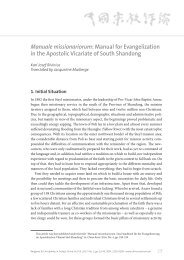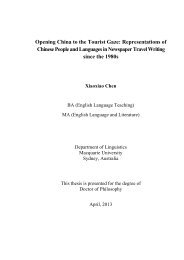EDUCATION IN CHINA
Education-in-China-a-snapshot
Education-in-China-a-snapshot
You also want an ePaper? Increase the reach of your titles
YUMPU automatically turns print PDFs into web optimized ePapers that Google loves.
Chapter 1 – Organisation and management of education in China<br />
are required to disclose whether they have a criminal<br />
record. All applicants should apply for the certificates<br />
in local educational administration departments at the<br />
county level. However, the certificates are issued by<br />
different departments according to their categories. As<br />
for qualification certificates for teachers in pre-school,<br />
primary school and junior secondary schools, they<br />
are issued by county-level governments. Qualification<br />
certificates for teachers in senior secondary school are<br />
issued by educational administrative departments in the<br />
upper level. Certificates for practical instructors are also<br />
issued by educational administrative departments or by<br />
other relevant departments. The certification process<br />
is more complex when it comes to higher education.<br />
Universities that are directly affiliated with the Ministry<br />
of Education or provincial-level governments have the<br />
right to issue certificates for their own faculties. Teachers<br />
at other universities must hold government-approved<br />
certificates.<br />
FIGURE 1.5 TEACHERS TYPES AT DIFFERENT LEVELS<br />
Teachers in colleges and universities<br />
Teachers in senior secondary schools<br />
Professional course teachers in<br />
secondary vocational schools<br />
Practical instructors in secondary<br />
vocational schools<br />
Teachers in junior secondary school, for professional course teachers in junior secondary vocational schools<br />
Teachers in primary schools<br />
Teachers in pre-school education institutions<br />
Source: Teacher’s Law of the People’s Republic of China, 1993.<br />
The qualification system has undergone reform<br />
recently. In the new system, the teacher’s qualification<br />
examination is held nationally. Every certificate applicant<br />
has to pass the examination except the applicants for<br />
higher education. In the past, the examination was<br />
held at the provincial level mostly, and graduates from<br />
dedicated teacher training schools were allowed to skip<br />
the exam. Currently, there are separate examinations for<br />
pre-school, primary, secondary and vocational education,<br />
all of which consist of two parts: the written examination<br />
and the interview. Further description of exam content<br />
is listed in Table 1.1. The written examination is<br />
taken partly on paper and partly on a computer. The<br />
interview includes a structured interview and situational<br />
simulation. Interviewers may ask applicants to answer<br />
questions from randomly selected topics. Or candidates<br />
may be asked to prepare a course, answer questions<br />
about it, present the course and create an evaluation for<br />
students based on the material.<br />
According to the Teacher’s Law, schools and other<br />
educational institutions should progressively adopt a<br />
system where teachers are recruited using employment<br />
contracts. The recruitment contract is issued by<br />
government at the county level and above, or by schools<br />
that demonstrate some special conditions. The whole<br />
recruiting process should be open and transparent, which<br />
makes the competition more equal. The tradition of<br />
permanent employment, what was known conventionally<br />
as the “Iron Rice Bowl”, has been challenged by the<br />
introduction of teacher contracts. Now teachers must,<br />
according to their terms of employment, satisfactorily<br />
meet regular inspections and appraisals.<br />
18 – <strong>EDUCATION</strong> <strong>IN</strong> CH<strong>IN</strong>A: A SNAPSHOT © OECD 2016





